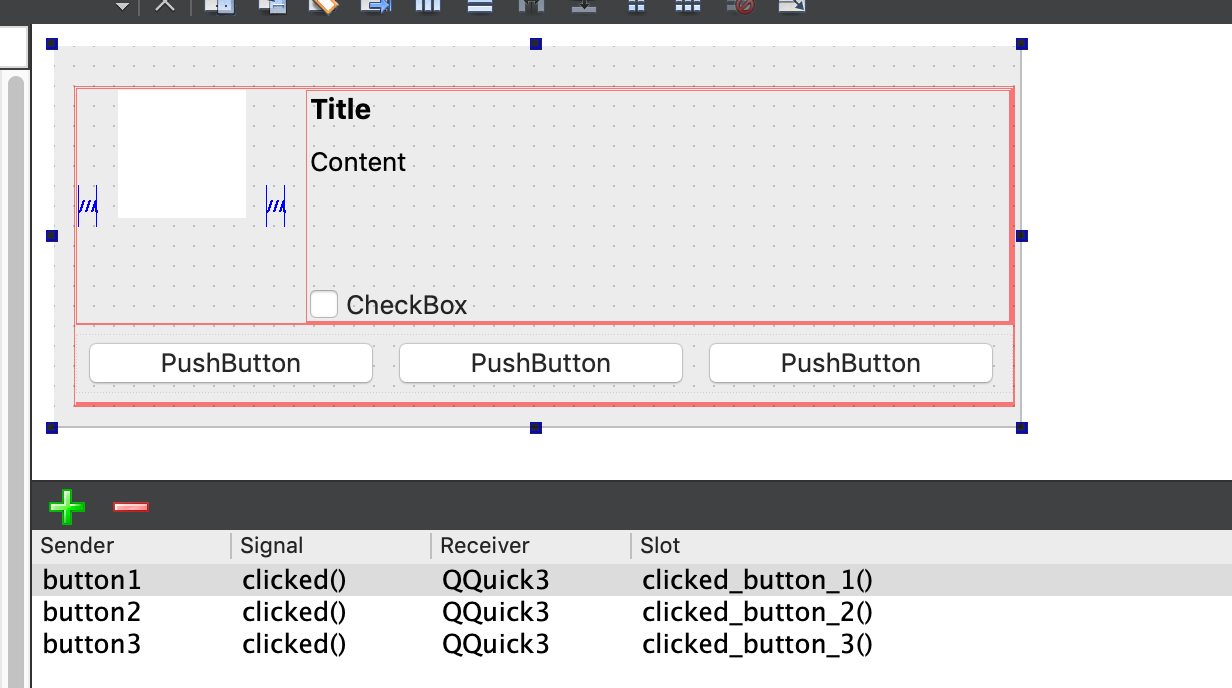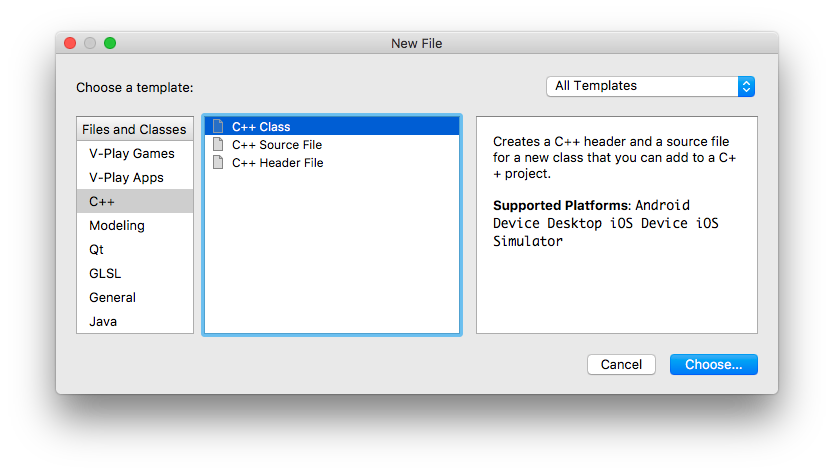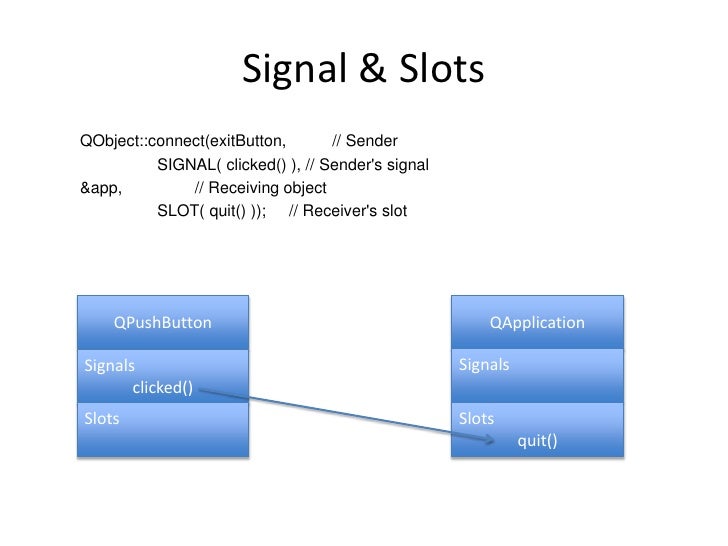Qt Create Slots And Signals
I have a Qt 'signal-slot connection'.
I want to test the class with the signal
The class with the slot is mocked/stubbed.
Now I would like to verify that when I emit signal, the slot is
called.
I wonder if it is possible to use gmock to verify this.
// class Tx contains the signal, which is protected so I inherit
// to get access to it
class Test : public ::testing::Test, public Tx
{ public:
MockRx *rx;
void SetUp()
{ rx = new MockRx;
rx->rxsignal(); // Just to see it compiles
rx->gmock_rxsignal(); // Compiles, gmock generated function
QObject::connect(this, SIGNAL(txsignal(), rx, SLOT(rxsignal()));
}
void TearDown() { delete rx; }
};
TEST_F(Test, Signal)
{
EXPECT_CALL(*rx, rxsignal()).Times(1).WillOnce(Return());
this->txsignal();
}
class MockRx : public QWidget
{ Q_OBJECT
public:
MOCK_METHOD0(rxsignal, void());
};
When running, I get the error:
QObject::connect: No such slot as RxMock::rxsignal()
If I remove Q_OBJECT in class MockRx, I get: No such slot as
QWidget::rxsignal()
I also tried to QObject::conntect(... SLOT(gmock_rxsignal()));
which gives No such slot as RxMock::rxsignal()
If I replace the MockRx class with a class Rx with rxsignal()
everything works.
I wonder why QObject::connect cannot find RxText::rxsignal() when
- it works if I replace with a regular class Rx instead of class
MockRx
- rx->rxsignal() can be called
Is gmock doing something under the hood that prevents this?
Hope someone can help, thanks a lot
Paul
- Creating custom slots and signals Important: Please read the Qt Code of Conduct - aha1980 Lifetime Qt Champion last edited by @Fuchsiaff.
- We will learn how to create custom signals and slots for C GUI Programming using Qt Toolkits. If you have some experience in GUI Programming, this episode is manageable or even simple.
Qt 5 signals and slots mechanism. How signals and slots in Qt differ from the callback architecture in other widget toolkits. A Qt basics tutorial. How to add signals and slots in Qt Creator.
Disconnect follows the same syntax as connect so 'disconnect(A,signal,B,slot)' could be read as: A no longer signals B in the slot. B can stop suffering now. Emitting the signal: A emits the signal by calling emit, all objects whose slots have been connected to that type of signal will be, emmm signaled then: void ObjectADialog:: onpushButton.
Qt Create Slots And Signals Free
Part 9 of the Qt Creator C++ Tutorial
What are Qt 5 Signals and Slots?
Very basically, signals and slots in Qt allow communication between objects.
In Qt, a signal is emitted when an event occurs. A slot is a function that is called when a signal is emitted. For example, a push button emits a clicked signal when clicked by a user. A slot that is attached to that signal is called when the clicked signal is emitted.
Multiple signals can be connected to any slot. Signals can be connected to any number of slots.
Most of the details of signals and slots are hidden in their implementation in Qt. At this stage of the tutorial series we do not look in depth at signals and slots.
Using Signals and Slots in Qt Creator
Qt Creator Slots And Signals
There are several ways to use signals and slots in Qt Creator projects. This includes manually adding them in code. Here we briefly look at the easier ways to use signals and slots to respond to events. Events are generated by users interacting with widgets in an application. These events cause signals to be emitted. Corresponding slots, or functions then run.
Qt 5 Signals and Slots Demonstration
The following image shows the application built in this section using Qt Creator. It demonstrates some methods of using signals and slots.

Each section below shows a method of adding signals and slots to a Qt Creator program. Watch the video embedded near the top of this page for details.
Qt Create Slots And Signals Online
Add a Slot to a Button for the Clicked Signal
Place a push button on the main window. Right click the push button and select Go to slot… to add code for the clicked signal.
Connect a Slider to a Progress Bar Visually
Place a Horizontal Slider and a Progress Bar on the main window.

Press F4 on the keyboard. This toggles to Edit Signals/Slots mode.
Drag to connect the slider to the progress bar.
Press F3 to change back to Edit Widgets mode.

Connect a Slider to a Progress Bar with Code
Place a second Horizontal Slider and a Progress Bar on the main window.
Right-click the Horizontal Slider. In the menu that pops up, click Go to slot…
In the dialog box that pops up, select sliderMoved(int). Click the OK button.
Add code for the sliderMoved signal.

Menu Bar Item with Action Editor

Add a File menu with Open, Close and Quit menu items.
Qt Creator must be in Design mode. Make sure that the Action Editor and Signal and Slots Editor are visible. Do this from the top menu as follows. Select Window → Views and then click the check box next to each of the desired editors.
Add slots for the triggered() signal for the Open and Close menu items. Do this in the Action Editor as follows. Right click a menu item. Click Go to slot… on the menu that pops up. Click triggered() in the dialog box that pops up and then click the OK button.
Add code in the slot function.
Menu Bar Item with Signals and Slots Editor
In Design mode, select the Signals and Slots tab. Click the big green + sign to add an item. Change the following for the new item.
- Sender : actionQuit
- Signal : triggered()
- Receiver : MainWindow
- Slot : close()
Code Listing
Below is the code listing for mainwindow.cpp for the example project. Follow the video embedded near the top of this page to add the code.
mainwindow.cpp